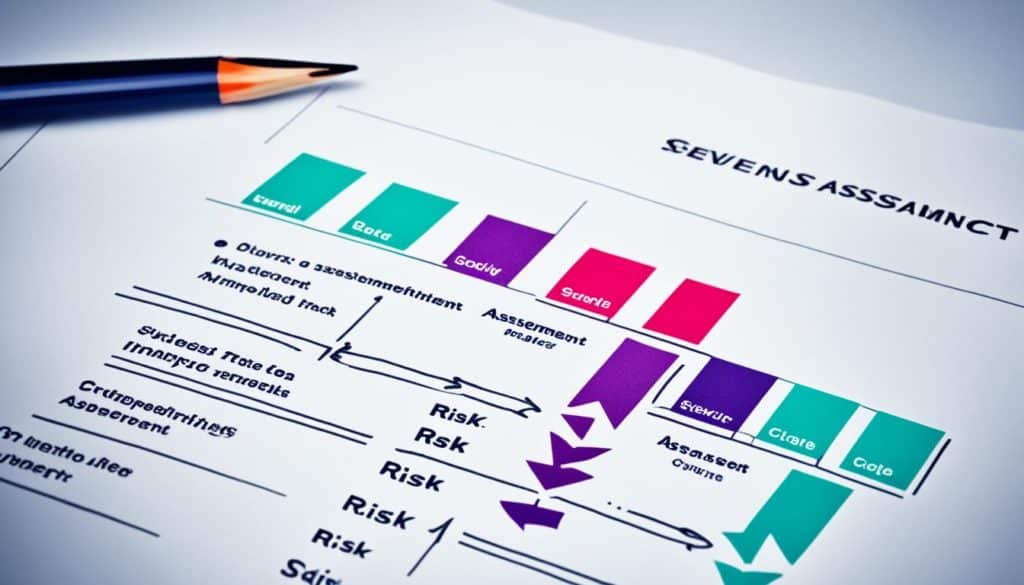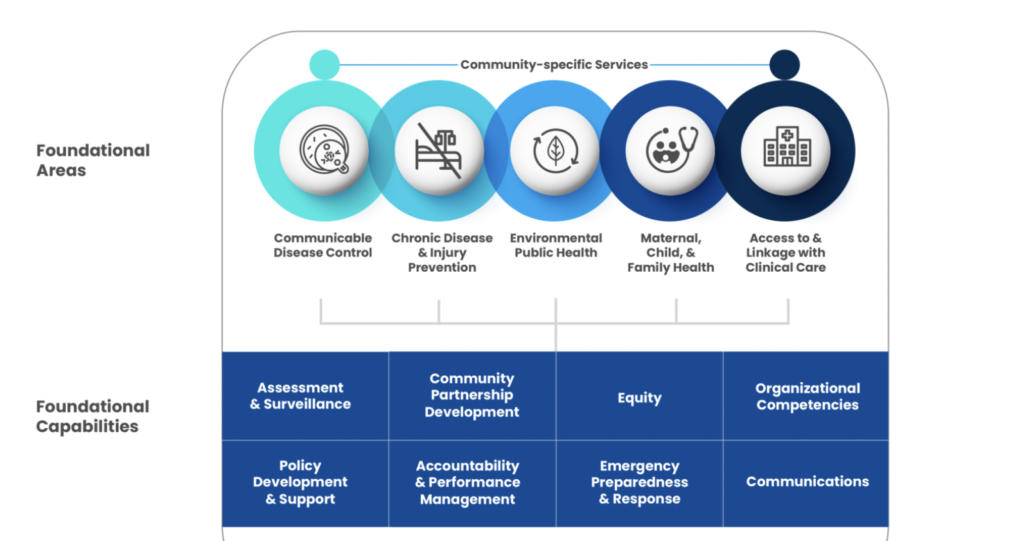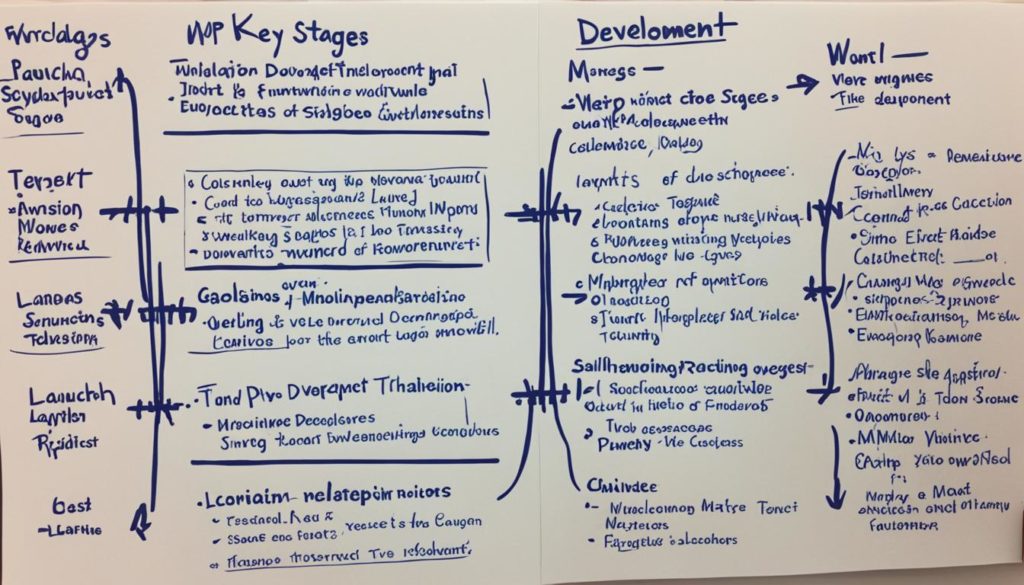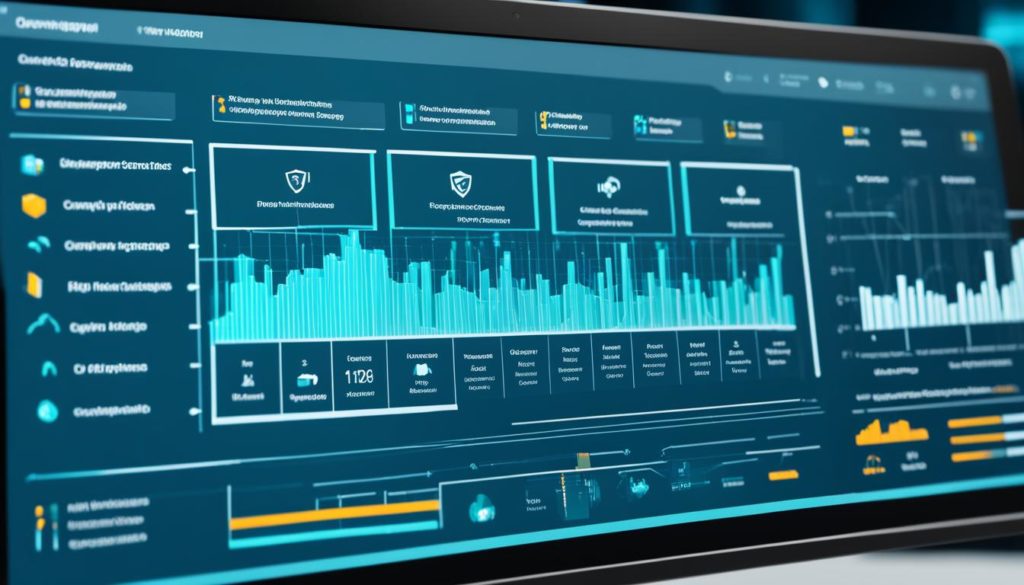
In incident management, knowing the difference between severity and priority is key. Severity measures how much an incident affects operations. It is based on specific guidelines. For example, Atlassian uses a system with SEV 1, SEV 2, and SEV 3 levels. This shows the impact of an incident and helps teams understand how quickly they need to act.
Severity looks at the issue’s impact, from small troubles to possible system failures. Priority decides when to handle these problems. It considers business needs and who is available to help1. This sorting helps manage resources well. It ensures urgent issues are fixed first. This keeps risks low and business running smoothly.
Key Takeaways:
- Severity levels (SEV 1, SEV 2, SEV 3) at Atlassian show how serious an incident is.
- SEV 1 and SEV 2 incidents get immediate alerts, showing they need quick action.
- This system helps teams act on the most important issues first.
- Sometimes, what the business needs can change the priority, showing flexibility is important.
- Quickly dealing with incidents keeps the business running and makes IT and DevOps teams more effective.
- Knowing how severity and priority differ helps create better plans for fixing issues.
The Critical Roles of Severity vs Priority
In IT operations and software development, solving technical issues well depends on knowing two main ideas: severity and priority. These concepts help teams decide how to approach problems. They also determine how resources are used and how successful the products and services will be for users.
Defining Severity in Issue Tracking
Severity levels help figure out how bad a defect affects system functionality. For example, Atlassian classifies incidents from SEV 1, where services are completely down, to SEV 3, which are minor glitches causing little trouble for customers1. Each level shows how much the system is impacted, helping prioritize fixing efforts.
Factors Contributing to Severity Levels
When evaluating severity, many factors matter. These include how often the issue occurs, if there are workarounds, and how much it stops users from having a good experience or affects system performance. A severe defect, or SEV 1, means the whole system is down. In contrast, minor bugs might slightly affect user experience (UX) but not much else.
Common Misconceptions About Severity
One common mistake is thinking an issue’s visibility or frequency equals its severity. The real way to measure severity is by looking at what part of the system functionality is at risk. This understanding is key to fixing defects in the right order, starting with the most urgent ones.
The Importance of Priority in Resolving Bugs
While severity looks at a defect’s technical effect, priority levels tell us how urgent and important it is to fix an issue. This urgency can range from high, needing fast action to avoid business impact, to low, where the problem can wait a bit longer to be resolved.
How Business Impact Influences Priority
Bugs that stop money from being made or harm the brand’s reputation are usually seen as high priority because they severely affect the business. On the other hand, issues that are less crucial might get a lower priority. This means they can be fixed during standard updates.
The Dynamics Between Priority and Project Timelines
The need to fix bugs quickly often comes from how tight the project deadlines are. For important issues, quick solutions are vital because they can really slow down project progress if not handled right away. A good priority strategy matches business goals and makes sure software is released without delay.
Distinguishing Between Severity and Priority
It’s crucial to know the difference between severity and priority. Severity is a fixed measure of a defect’s impact. Priority, however, can change based on current business needs and how critical other problems are during the development process.
Examples of Severity and Priority in Practice
Severity and priority examples make these concepts clearer. A big bug causing a system crash (high severity) could be seen as a high priority if it blocks access to important functions. A small bug affecting a less important feature might be low priority, having little effect on the overall experience.
Severity Levels: From Minor Inconveniences to System Shutdown
Severity levels show how much they can mess up operations. They go from SEV 3, which are small problems, to SEV 1, which are big emergencies that greatly harm functionality. Understanding these levels helps track and fix issues effectively.
Setting Priorities: Business Considerations
Choosing which defects to fix first is all about knowing the business considerations. Problems that could become big issues should be dealt with quickly. This avoids problems with making money, keeping customers happy, and staying ahead of competitors. Setting priorities right means dealing with the biggest and most important issues first.
A deep understanding of severity and priority is key to solving defects well. By knowing the impact and urgency, companies can fix issues fast. This keeps their products strong and uses resources wisely.
Evaluating the Impact: How Severity Affects the Bottom Line
In business risk management, understanding how defects impact functionality is crucial. Severity assessment helps us see how errors affect operations. If there’s a big difference between how things are and how they should be, fixing it becomes urgent. This is similar to how the gap in healthcare shows the severity of a patient’s condition1.
Severity scores range from 0, meaning little impact, to 100, meaning very severe outcomes. This helps businesses figure out how far off things are from normal4. As companies try to lower business risks, deciding the importance of each defect is key. They must consider several factors, like system performance, customer satisfaction, and income.
| Severity Score | Functionality Impact | Resource Allocation Priority |
|---|---|---|
| 0-25 | Minimal effect on operations | Low |
| 26-50 | Some disrupted functions; workarounds available | Medium |
| 51-75 | Major functionality compromised; user dissatisfaction | High |
| 76-100 | Critical failure; potential business shutdown | Immediate |
The concept of severity is also crucial in healthcare. Like in business, there’s debate over its meaning and how it affects decisions. When we assess a defect criticality, it’s not just about giving it a score. It’s about comparing the issue to what’s ideal. This highlights the need for detailed assessments and careful planning in business.
Urgency and Criticality: Developing a Priority Strategy
Creating a priority strategy is key for IT and DevOps teams. They often deal with different problems that can affect their work and customer happiness. Using severity levels like those by Atlassian helps manage responses to issues. These levels range from SEV 1 for big problems to SEV 3 for small issues. It’s crucial to know the difference between major problems, like customer data loss, and less critical ones. This helps send fast alerts to the right professionals for quick fixes1.
Good incident management uses tools like Jira Service Management. These tools help with scheduling and talking in real-time, especially during unexpected times for SEV 1 and SEV 2 issues. It’s interesting to note that not every problem needs instant action. This shows the importance of a detailed priority strategy. Such a strategy considers the team’s size and how often problems happen.
Understanding how to classify defects is about measuring their impact and balancing tech needs with business goals.
This concept is similar to how emergency plans are made. The Comprehensive Preparedness Guide 101 (CPG 101) teaches officials to create emergency plans for all situations. It highlights working together as a community and coordinating across different government levels. The guide’s updated advice shows how to involve people, mix in key preparedness ideas, and organize planning. This is crucial for handling disasters effectively.
- SEV 1: Immediate attention for critical incidents with very high impact.
- SEV 2: Prompt response for major incidents with significant impact.
- SEV 3: Scheduled attention for minor incidents with low impact.
| Severity Level | Incident Example | Business Impact | Response Urgency |
|---|---|---|---|
| SEV 1 | Security breach | Very High | Immediate |
| SEV 2 | Service malfunction | High | Prompt |
| SEV 3 | System glitch | Moderate | Scheduled |
Comparing IT incident management to emergency planning shows similarities. Both involve digital disruptions and all-threat preparations. The key focus is on priority strategy and working with the community. This approach ensures we meet the needs of people and customers effectively
Prioritizing Issues: A Guide for Productive Resolution
In public health, prioritizing issues is key for effective action. A study of 16 domains shows why a good resolution guide is important in tackling health challenges. Looking at urgency and public welfare, we learn from global assessments like J-RANS II how crucial this link is.
Data shows a lot of ‘level 3’ suffering in areas like health and nutrition. This highlights the need for a smart defect triage system. It should look at issue severity and its social impact7. Including people’s opinions, through things like focus groups, helps make better public health decisions.
Using many approaches in prioritization improves the process and fits better with public health needs. A table based on research could show how severity and priorities match up in places like Northern Syria and Yemen. It tells us how different factors affect where resources go.
| Severity Scale | Priority Scale | Public Health | Education | Protection |
|---|---|---|---|---|
| Level 3 – Many Suffering | High Priority | 33 Studies | 7 Sectors | 7 Sectors |
| Quantitative Criteria | Qualitative Aspects | Burden of Disease | Social Considerations | Health Intervention Impact |
This table shows how prioritizing issues needs more than just numbers. It uses both hard data and people’s experiences to get the full picture of public health plans.
The foundation for effectively prioritizing public health issues is informed by a rich tapestry of evidence, designed to streamline both resource allocation and resolution methodologies for an optimal impact on community well-being.
The resolution guide and urgency assessment show that good prioritization looks at many levels. It balances the facts with the bigger picture of social issues.
Managing Business Risks Through Effective Prioritization
Companies face a world full of risks and must build risk management deeply into their plans. To stay strong and competitive, they need an effective risk management system as per the German Supply Chain Act. This system helps avoid violations relating to human rights or the environment.
It’s key to line up business goals with annual and on-the-spot risk evaluations. Doing this yearly, as laws demand, is critical for weaving the results into business planning. Both strategies and daily operations benefit from this, making sure the company is ready for risks.
Having a solid defect triage system is vital. By doing regular, sharp risk studies, companies can make plans to stop big risks before they happen. This approach covers not just the company, but also the suppliers, ensuring all meet their due diligence.
Part of fixing defects well includes putting lessons from risk studies into action. This improves how effective actions and plans are at preventing issues. Focused efforts here can point out where future problems might occur, making companies better at managing risks and using their resources wisely.
| Risk Analysis Frequency | Coverage Scope | Outcomes Incorporated Into |
|---|---|---|
| Annually and ad hoc | Full business area and direct suppliers | Strategic and operational planning |
| Ad hoc, upon substantiated knowledge | Indirect suppliers | Preventive measures and complaint procedures |
This example, backed by data, shows how crucial risk analysis is. It’s a main support for how an organization handles risk management, decides on resources, and makes choices about risks.
Conclusion
At the heart of managing workflow in software development lies the strategic choice between Severity and Priority. Each bug is a part of the bigger picture of a project’s health. It shows why we need to focus on both technical severity and business priority. Understanding this balance helps teams tackle issues effectively and focus on what moves a project forward.
Severity is about how much a bug affects the system, from big problems to small ones. Priority decides how soon we fix these bugs—from issues needing immediate attention to those that can wait. A bug with high priority might not always be severe. For example, a visual bug can annoy users without causing system failure. It’s urgent to fix but not severe.
In healthcare, severity is crucial, shown through a four-level scale. It highlights the gap between actual and ideal health levels. This scale helps in fair distribution of healthcare services. Likewise, in software testing, bugs range from critical to minor. This guides us in setting priorities to keep both the system’s integrity and user happiness.
“Mastering the interplay of severity and priority is not just about fixing what’s broken; it’s about making informed choices that underpin both the product’s integrity and the user’s journey.”
This relationship requires careful assessment. It’s where the need to prevent risks meets timing. Sometimes, a bug affecting the product might get high priority even if it’s not severe. This ensures users stay safe from possible issues. Thus, even less severe defects can become a high priority to prevent user impact.
| Defect Category | Severity | Priority | Impact |
|---|---|---|---|
| Blocker | Critical | High | Must be resolved immediately to prevent significant usability issues. |
| Major | High | Medium | Requires timely fix but may not compromise entire application. |
| Minor UI Bug | Low | High | Despite lower technical severity, prioritized due to user experience concern. |
| Rarely Used Feature | High | Low | Low priority assigned due to infrequent encounter by users. |
Managing severity and priority well prevents obvious bugs and protects against financial losses from workflow issues. The takeaway is clear. Skillfully managing Severity vs Priority in issue management is essential. It balances operational quality and business insight. This leads to creating top-notch applications. Applications that meet user and stakeholder needs well.
Suggested Reading:
Learning to tackle problems in software development and IT is crucial. For those looking to dig deeper, severity vs priority resources are invaluable. They help improve skills in advanced issue management. This path guides you in handling issues based on how urgent and impactful they are.
Atlassian’s incident system serves as a prime example. It uses a detailed 3-tier SEV system for sorting issues. This helps understand the difference between issue severity and how each is prioritized. It encourages continuous improvement in solving problems. For IT and DevOps teams, mastering this is key to providing top-notch services. It also helps in keeping customers happy and upholding brand quality.
The way we classify and respond to incidents changes as the industry grows. Looking into severity vs priority resources arms teams with the right knowledge. This knowledge aids in making smarter decisions for a smoother experience for everyone involved. Remember, the urgency and importance of an issue don’t always match up. Understanding this balance is crucial for effective problem-solving1.
FAQ
What is the difference between severity and priority in issue tracking?
Severity talks about how a bug affects the system’s work. Priority shows how quickly we need to fix it. Severity is all about technical impact. Priority decides the order for fixing issues.
What factors contribute to determining an issue’s severity level?
Several things set an issue’s severity. These include how often it happens and if there’s a workaround. They also look at its effect on system performance and overall operations.
How do common misconceptions about severity affect issue resolution?
Mixing up severity with priority can mess up resources. We must fix the most impactful defects first. It’s about true impact, not just visibility.
Why is prioritizing defects based on urgency important?
Sorting defects by urgency helps fix big threats first. This keeps projects on time and saves the user experience. It also matches up with business goals.
How does business impact influence the priority of resolving bugs?
Bug fixing priorities lean heavily on business effects. Issues hurting operations or customer happiness need fast action. Quick fixes reduce bad impacts.
Can priority levels change over time?
Yes, priorities may shift with new issues or goals. Changing business aims or deadlines also play a part. Priority moves with business and project needs.
How do severity and priority work together in issue resolution?
First, we measure how a defect impacts technically. Then, we decide how soon to fix it. This makes sure critical issues are solved first and business goals are met.
Can you give an example of severity and priority in practice?
A total system failure is very severe. If it’s vital for business, fixing it becomes top priority. Conversely, a simple UI spelling error might be less severe. But, if it’s on a key sales page, its priority rises due to potential sales impact.
What different severity levels are there in issue categorization?
Severity ranges from low to critical. Low means little effect on operations. Critical means big troubles, maybe even system shutdown.
What are the business considerations when setting priorities for defect resolution?
When setting priorities, we weigh potential revenue loss and user importance. We think about customer upset and competitors too. These guide how quick a fix should happen.
How does understanding severity help manage business risks?
Grasping defect severity aids in tackling system and satisfaction risks. Knowing severity levels helps plan and prioritize for a smooth operation and quality.
What components constitute an effective priority strategy?
A good strategy reviews defect urgency and business impact. It accounts for resource availability. Stakeholder input also guides which issues to tackle first.
How can prioritizing issues lead to productive resolution?
Focused prioritization lets teams tackle urgent defects well. It ensures smart use of time and maintains product quality, easing user and business strain.
What is the role of risk management in prioritizing defects?
Risk management looks at the biggest threats to business and users. Good prioritization lowers these risks, boosting product reliability and trust.
Where can I find more resources on severity vs priority for further learning?
For more, check out testing and quality assurance books. Tech blogs, tool docs, and professional courses also offer deep dives into issue and defect management strategies.
Future App Studios is an award-winning software development & outsourcing company. Our team of experts is ready to craft the solution your company needs.










